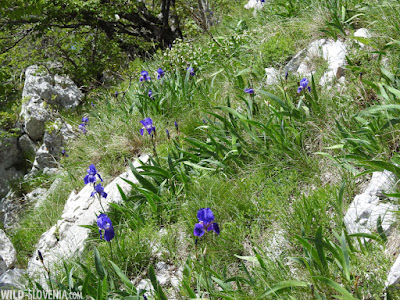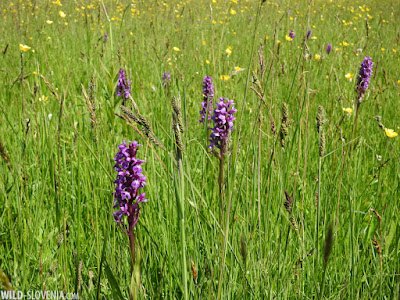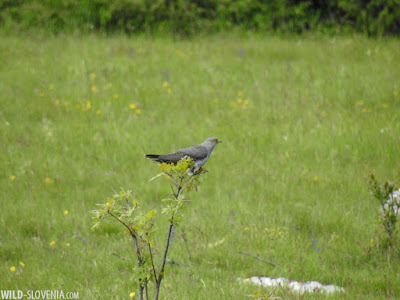
For us, the end of May is certainly the best period of the whole year. Spring is really in full swing, warm temperatures make the stay outside finally pleasant, while wildlife is abundant and easily observable. Mount Nanos (1242 m), a geographical border between the sub-Mediterranean Primorska region and the continental part of Slovenia is a must in this season. In the last days of May we made our traditional ascent to this fantastic mountain, rich in a variety of wildlife, especially interesting plants. This year the vegetation season is quite late, especially in the mountains and many of the plants that we usually see on Nanos at the end of May, this year weren't out yet. For example the Ramsons
Allium ursinum in the beech forest on Nanos' northern slope were not yet in bloom. Still, we enjoyed other species we don't see so often, including some rare or localised ones like
Scopoli's Rockcress Arabis scopoliana, an endemic of the SE Alps and the Dinaric mountains, named after
J.A. Scopoli. Among birds the highlights were two typical species of sunny rocky slopes: a male
Rock Thrush Monticola saxatilis and several singing
Rock Buntings Emberiza cia.
Crag Martin Ptyonoprogne rupestris,
Honey Buzzard Pernis apivorus and
Tree Pipit Anthus trivialis were some of the other birds encountered. For a similar post with similar content (from spring 2020) see
here.
 |
Mount Nanos - the landmark of Primorska.
|
 |
Limestone screes on Nanos' SW slopes, habitat for reptiles.
|
 |
European Green Lizard Lacerta viridis
|
 |
Alpine Mezereon Daphne alpina
|
 |
Mossy Sandwort Moehringia muscosa
|
 |
Thermophilous woodland on Nanos' SW slopes.
|
 |
A clearing on the wooded limestone slope, revealing...
|
 |
Illyrian Irises Iris illyrica in full bloom.
|
 |
White Asphodel Asphodelus albus
|
 |
Thermophilous mix: Peony Paeonia officinalis, Illyrian Iris Iris illyrica and White Asphodel Asphodelus albus.
|
 |
Common Peony Paeonia officinalis
|
 |
Grass-leaved Iris Iris graminea - loved (and pollinated) by ants.
|
 |
Coming out of the woodland, just above the treeline.
|
 |
A view over the hills bordering the Vipava valley and the Karst plateau (with the Adriatic in the distance).
|
 |
Rock Bunting Emberiza cia feeding on grass' seeds.
|
 |
| Rock Bunting Emberiza cia |
 |
Rock Bunting's habitat.
|
 |
Rock Thrush Monticola saxatilis
|
 |
Silvery Broom Genista sericea
|
 |
Dwarf Buckthorn Rhamnus pumila
|
 |
Wood Treacle Mustard Erysimum sylvestre
|
 |
Scopoli's Rockcress Arabis scopoliana - endemic of the SE Alps and Dinaric mountains.
|
 |
A possible Bitter Milkwort Polygala amara
|
 |
The slopes of Suhi vrh, in the NE part of the Nanos plateau.
|
 |
South-western slopes of Nanos descending in the Vipava valley.
|
 |
Fresh new beech leaves on the Nanos plateau.
|
 |
Mt. Triglav (Slovenia's highest peak) visible to the N - looking still very much wintry.
|
 |
Meadows on Nanos, looking west over the Karst plateau and the Adriatic sea.
|
 |
Mountain Pasqueflower Pulsatilla montana - a very late bloom.
|
 |
We found the perfect pic-nic spot.
|
 |
Honey Buzzard Pernis apivorus
|
 |
Mt. Snežnik in the distance, looking SE.
|
 |
Beech Longhorn Beetle Morimus funereus on the path from Nanos.
|
Meanwhile, in the valley of the Nanoščica river, to the east of Nanos' plateau, wet meadows are in full bloom. The beginning of June is the best time to enjoy the spectacle of Siberian Irises Iris sibirica adorning the meadows in large blue patches, mixed with other wet-loving plants such as pink carpets of Ragged-robin Lychnis flos-cuculi, Early Marsh Orchids Dactylorhiza incarnata and the rarer Bog Orchids Anacamptis palustris. In Slovenia these meadows, supporting also other interesting wildlife such as Corncrake Crex crex, Barred Warbler Sylvia nisoria, Large Copper Lycaena dispar and Scarce Large Blue Phengaris teleius (to name just a few) are increasingly under pressure by agricultural intensification & conversion into farmland/intensive pastureland. Fortunately some biodiversity-rich areas are still to be found in the Nanoščica river basin.
 |
Wet meadow with Siberian Iris Iris sibirica and the ridge of Suhi vrh (Nanos) in the background.
|

 |
Siberian Iris Iris sibirica
|
 |
Yellow Flag Iris pseudacorus
|
 |
Early Marsh Orchid Dactylorhiza incarnata
|
 |
Bog Orchid Anacamptis palustris
|
 |
Ragged-robin Lychnis flos-cuculi
|
 |
Summer Snowflake Leucojum aestivum
|
 |
Hobby Falco subbuteo defending its nesting site from a Buzzard Buteo buteo
|
During our fieldwork on White-backed Woodpeckers Dendrocopos leucotos ssp. lilfordi on mount Snežnik (came across a fledged juvenile, while another pair was still feeding chicks), we regularly drove by the valley of the Pivka seasonal lakes. At the end of May, flocks of migrant Red-footed Falcons Falco vespertinus were easily seen, perched on wires, while we also regularly watched Barred Warblers Sylvia nisoria in song-flight. As mentioned in the previous post, here Red-backed Shrikes Lanius collurio are definitely the commonest species of bird!
 |
White-backed Woodpecker Dendrocopos leucotos ssp. lilfordi, fledged female.
|
 |
White-backed Woodpecker Dendrocopos leucotos ssp. lilfordi - male carrying food to the nest.
|
 |
Red-footed Falcon Falco vespertinus in the Pivka valley with Mt. Snežnik as a backdrop.
|
 |
Red-footed Falcon Falco vespertinus - young male.
|
 |
Red-footed Falcon Falco vespertinus - female.
|
 |
Barred Warbler Sylvia nisoria
|
 |
Red-backed Shrike Lanius collurio
|
 |
River Pivka with the Snežnik plateau in the distance.
|
 |
River Pivka
|
Recent fieldwork also took us to the dry grasslands of the Karst edge, between Osp and Rakitovec. At this time of year the karstic flora of limestone grasslands is at its best, with nice stands of colourful Sage Salvia officinalis, buzzing with swarms of bees. In one of these stands we came across an exceptionally white-headed female Honey Buzzard Pernis apivorus perched on the ground, watching the bees with interest (Hymenopteras' larvae are the buzzard's main food). As we approached with the car, the buzzard changed perches a few times, but didn't go far, allowing excellent views. Later it was even joined by another Honey Buzzard, this time a male. We watched both for some minutes, before they took off. During our bird censuses we also recorded an Ortolan Bunting Emberiza hortulana, one of Slovenia's rarest breeding birds (6-10 singing males left in the whole of the country!), in an area where the species vanished some year ago. However the bird was fleeting and we didn't even manage to see it - it was probably just an unpaired male, moving around great distances and singing. In one of the several nest-boxes on small oaks in the open meadows we found a nest of Hoopoes Upupa epops, the parents already feeding their chicks. The grasslands were otherwise productive with all sorts of common breeding birds like Red-backed Shrike Lanius collurio, Corn Bunting Emberiza calandra, Skylark Alauda arvensis, Woodlark Lullula arborea, Quail Coturnix coturnix, Stonechat Saxicola torquatus, Melodious Warbler Hippolais polyglotta and even some introduced Northern Bobwhites Colinus virginianus. After a tragically cold spring for butterflies, some species seem to be doing well now, for example Black-veined Whites Aporia crataegi and Glanville Fritillaries Melitaea cinxia, both very common in the meadows at the moment.
 |
(Wild) Sage Salvia officinalis
|
 |
Honey Buzzard Pernis apivorus - female.
|
 |
| Honey Buzzard Pernis apivorus - male. |
 |
Hoopoe Upupa epops catching a Scolopendra for its chicks - bleugh!
|
 |
Nest-box with Hoopoe's chicks inside.
|
 |
Cuckoo Cuculus canorus
|
 |
Glanville Fritillary Melitaea cinxia
|
 |
Safflower Skipper Pyrgus carthami
|
 |
Assman's Fritillary Melitaea britomartis
|
 |
Black-veined White Aporia crataegi
|
 |
Crab Spider (Thomisidae) waiting for a butterfly.
|
 |
Slow-worm Anguis fragilis
|
 |
Dry karstic grassland.
|
 |
Two typical species of karstic grasslands: Stipa eriocaulis & Scorzorena villosa.
|
 |
Dittany Dictamnus albus
|
 |
Carniolan Vetch Astragalus carniolicus (with the type locality on Mt. Nanos).
|
In the few moments of free time we also went to check some breeding birds in our local patch, not far from where we live. Remember the nest of Eagle Owls Bubo bubo we found in the Karst back in March? Two
months later and now there's a big chick in the nest, safely guarded by the
vigilant female. The photos below were taken from a great distance, using a
telescope and a smartphone camera. At the moment, some slightly older Eagle Owl chicks
can be followed on the second live-cam on this link (although they're
not always in the nest!). In a forest not far from home, we have been also following the breeding of Black Woodpecker Dryocopus martius, now for the 4th consecutive year. In the last days of May there were at least 3 visible chicks at the nest entrance, now probably already fledged. On the local front, also this year we had a Great Spotted Woodpecker Dendrocopos major nesting in the woodland behind the house (as we're fond of woodpeckers, even the commonest species makes us happy!), while at least two different Common Redstarts Phoenicurus phoenicurus wake us up every morning at dawn with their beautiful song - priceless!

 |
Eagle Owl Bubo bubo - female on the nest with chick.
|
 |
Black Woodpecker Dryocopus martius - female feeding one of the 3 juveniles.
|
 |
Great Spotted Woodpecker Dendrocopos major - female carrying food.
|
 |
Common Redstart Phoenicurus phoenicurus on the neighbour's roof.
|
 |
Scopoli's Longhorn Beetle Cerambyx scopolii
|
We'll round up this post with some more leisure-orchid-botany content. On an interesting botanical visit to the Slovenian Istria in late May, we enjoyed in several of the typical orchids of this area, but also with the visit of a "weed field" - a wheat/barley field cultivated the old way, allowing also the growth of some rare species of almost-extinct agricultural weeds. Finally some interesting and rare species of grass, typical of the Mediterranean region. Check the pics below.
 |
Adriatic Lizard Orchid Himantoglossum adriaticum
|
 |
Pyramidal Orchid Anacamptis pyramidalis
|
 |
Bug Orchid Anacamptis coriophora ssp. fragrans
|
 |
Long-lipped Serapias Serapias vomeracea
|
 |
Lax-flowered Orchid Anacamptis laxiflora
|
 |
Bee Orchid Ophrys apifera
|
 |
Late Spider Orchid Ophrys holosericea
|
 |
Wheat/barley field in Istria.
|
 |
Common Poppy Papaver rhoeas
|
 |
Pheasant's-eye Adonis annua
|
 |
Corn Crowfoot Ranunculus arvensis
|
 |
Rough Corn Bedstraw Galium tricornutum
|
 |
Corn Gromwell Buglossoides arvensis
|
 |
Small Restharrow Ononis reclinata
|
 |
Three-awn Goatgrass Aegilops neglecta
|
 |
Ovate Goatgrass Aegilops geniculata
|
 |
Delicate Hair-grass Aira elegantissima
|














































































































